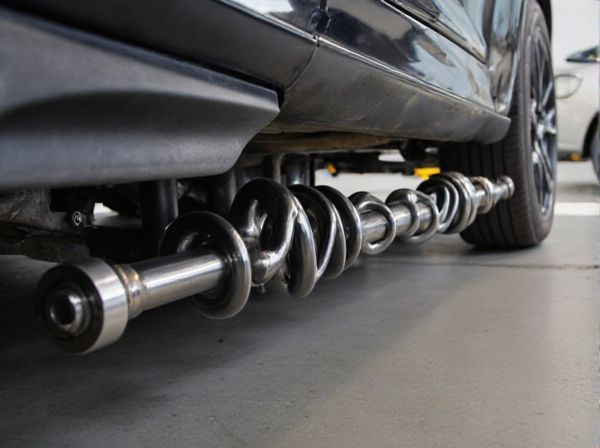
Photo illustration: Direct Driveshaft vs Torque Tube Driveshaft
A direct driveshaft offers a straightforward connection between the transmission and the rear differential, providing efficient power transfer with minimal drivetrain flex, ideal for high-performance applications. Torque tube driveshafts encase the driveshaft within a rigid tube, enhancing structural integrity and reducing drivetrain movement under heavy loads, commonly found in trucks and muscle cars for improved durability. Your choice depends on the desired balance between performance precision and durability in demanding driving conditions.
Table of Comparison
| Feature | Direct Driveshaft | Torque Tube Driveshaft |
|---|---|---|
| Design | Open shaft connecting transmission to rear differential | Encased shaft within a rigid tube for added support |
| Alignment | Requires precise alignment, prone to vibration | Self-aligning, reduces vibration and shaft movement |
| Durability | Less durable under heavy load, exposed to debris | More durable, shaft protected inside torque tube |
| Maintenance | Easier to inspect and service | Complex maintenance due to enclosed design |
| Weight | Lighter overall system | Heavier due to additional housing |
| Common Use | Standard in most modern rear-wheel-drive cars | Typical in classic and some heavy-duty vehicles |
| Cost | Lower manufacturing and repair costs | Higher costs due to complex construction |
Introduction to Driveshaft Systems
Driveshaft systems are essential components in vehicle powertrains, transmitting torque from the engine or transmission to the wheels. Direct driveshafts offer a straightforward, efficient connection with fewer components, reducing rotational mass and enhancing responsiveness. Torque tube driveshafts encase the shaft within a rigid tube, providing structural support and better control of torque reactions, often improving durability in heavy-duty applications.
What Is a Direct Driveshaft?
A direct driveshaft is a mechanical component that transmits torque from the engine or transmission directly to the rear differential without intermediate supports or housings, offering a more straightforward and efficient power delivery system. It reduces rotational mass and potential points of failure compared to torque tube driveshafts, which use an enclosed tube to house the driveshaft and support vehicle rear end alignment. Direct driveshafts are preferred in performance and off-road applications due to their simplicity, ease of maintenance, and ability to handle higher torque loads.
What Is a Torque Tube Driveshaft?
A torque tube driveshaft is a drivetrain component that encloses the driveshaft within a rigid tubular housing, connecting the transmission to the rear axle to manage torque and alignment. This design improves drivetrain rigidity, reduces vibrations, and enhances power transfer efficiency by maintaining precise alignment between the driveshaft and rear differential. Compared to a direct driveshaft, the torque tube setup provides better structural support and is commonly used in vehicles requiring high torque control and stability.
Key Differences Between Direct and Torque Tube Driveshafts
Direct driveshafts feature an exposed, straight shaft connecting the transmission to the rear axle, allowing for simpler design and easier maintenance. Torque tube driveshafts encase the driveshaft within a rigid tube, providing additional structural support and better handling of torque reaction forces. The key differences lie in design complexity, torque reaction management, and overall vehicle durability, with torque tubes offering enhanced drivetrain stability at the expense of increased weight.
Performance Comparison: Direct vs Torque Tube
Direct driveshafts offer improved performance by reducing rotational mass, resulting in quicker acceleration and sharper throttle response compared to torque tube driveshafts. Torque tube driveshafts provide better drivetrain rigidity and improved torque handling, which enhances overall vehicle stability during high-torque applications. Performance-focused vehicles typically favor direct driveshafts for lightweight efficiency, while torque tube setups excel in heavy-duty and off-road performance due to enhanced durability.
Durability and Maintenance Factors
Direct driveshafts offer enhanced durability due to their simpler design and fewer moving parts, reducing the risk of wear and mechanical failure over time. Torque tube driveshafts use a rigid enclosed housing which enhances alignment and protection but can lead to more complex maintenance and potentially higher repair costs if issues arise. Maintenance for direct driveshafts is generally easier and less frequent, while torque tube driveshafts require regular inspection of the enclosed components to ensure optimal performance.
Application Scenarios for Each Driveshaft Type
Direct driveshafts excel in high-performance applications such as sports cars and racing vehicles, where reduced rotational mass and improved responsiveness are critical. Torque tube driveshafts are preferred in heavy-duty trucks and off-road vehicles due to their superior torsional stiffness and ability to handle higher torque loads while protecting driveline components. Selecting the appropriate driveshaft depends on factors like vehicle weight, torque requirements, and intended usage conditions to optimize driveline efficiency and durability.
Pros and Cons: Direct Driveshaft
Direct driveshafts offer advantages such as reduced weight, increased efficiency, and easier maintenance due to their simpler design and fewer components. They provide better power transfer with less rotational mass, enhancing vehicle performance and responsiveness. However, drawbacks include higher susceptibility to vibrations and potential alignment challenges, which can lead to increased wear if not properly managed.
Pros and Cons: Torque Tube Driveshaft
Torque tube driveshafts provide enhanced structural rigidity by enclosing the driveshaft within a rigid tube, resulting in improved power transmission and reduced driveline vibration. This design offers better alignment and load distribution, which minimizes wear on suspension components and enhances vehicle stability during acceleration. However, torque tubes typically add weight and complexity to the drivetrain system, potentially limiting suspension travel and making repairs or maintenance more challenging compared to direct driveshaft setups.
Choosing the Right Driveshaft for Your Vehicle
Choosing the right driveshaft for your vehicle depends on factors such as vehicle type, suspension design, and desired performance. Direct driveshafts offer simplicity and cost-effectiveness, ideal for light trucks and mild off-road use, while torque tube driveshafts provide enhanced structural integrity and reduced vibration, suitable for heavy-duty or high-performance applications. Understanding load distribution and drivetrain layout ensures optimal power transfer, durability, and driving comfort tailored to your vehicle's needs.
 caratoz.com
caratoz.com